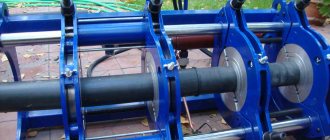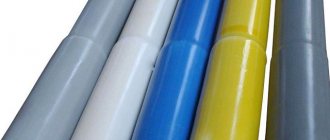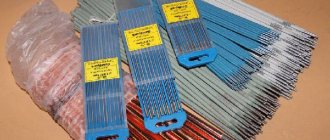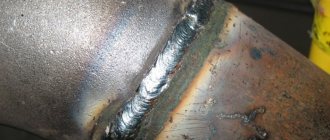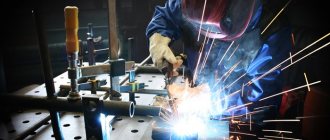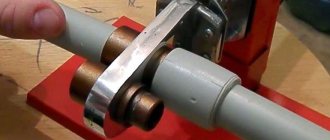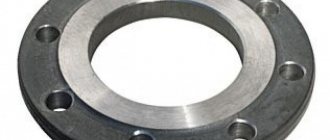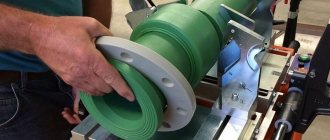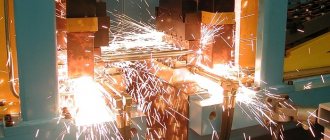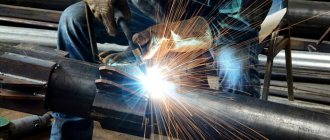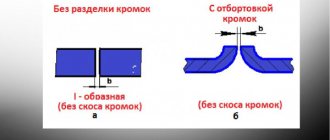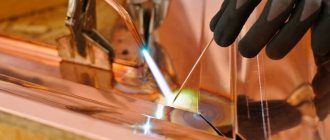Polyethylene pipes with a diameter of 2-120 cm are often used for laying water pipes, gas pipelines, and storm sewer equipment. They are durable, resistant to corrosion, lightweight, and easy to install. Welding is used to connect products. It can be of different types. The most popular is butt welding of polyethylene pipes. It ensures a sealed and aesthetically pleasing seam.
Usually, specialists are hired to lay the highway. But would you agree that professional services are not cheap? In addition, not all craftsmen are conscientious and take a responsible approach to fulfilling orders. If you have certain knowledge and skills, you can do the work yourself. This will save money and guarantee quality results.
We will talk about the technology for welding polyethylene pipes using the butt method, provide a detailed algorithm of actions, provide links to regulatory documents and tips that should be followed when performing such work.
Types of PE pipe connections
Polyethylene pipes can be connected into a single pipeline using different methods. Moreover, each of them is suitable for specific conditions.
- Thus, joining HDPE tubes using fittings and couplings (socket welding) is used mainly for constructing the internal part of the water supply system in the house.
- DIY pipeline installation using butt welding. This method is used for installing an extended section of outdoor communications. In this case, pipes can be laid both on the surface of the soil and in a trench, followed by covering them with soil.
- Electrofusion welding. This method of connecting HDPE tubes is done using special plastic couplings with spiral elements built into them, which heat up as a result of the supply of current to it.
Let's take a closer look at each of the methods.
Introduction.
These operating instructions are based on the current regulations regarding machines and equipment for butt welding of thermoplastics. In order to prevent dangerous situations at all stages of operation of the device, first of all, special attention is paid to aspects of occupational safety. It is important to know that the instructions should be read carefully before use. It should also be used during startup of the device and always kept at hand. Compliance with all of the above recommendations will ensure the achievement of three main goals:
- Ensuring the correct operation of the machine;
- Preventing the danger of injury to the operator when working with the product;
- Prevent device damage.
Important! Before you start working with the device, you must carefully read these “Operating Instructions”.
Recommendations for proper welding of PE pipes
Polyethylene pipes can be welded using special equipment called a soldering iron. At the same time, there are a number of certain rules that will make the connection of elements smooth, high-quality and airtight.
The requirements look like this:
- Before carrying out work, it is worth studying the HDPE characteristics for each pipe and verifying their compliance from certificates. Otherwise, the tubes simply will not fit together into a single sealed structure.
- The internal lumen of the tubes (diameter) must be identical for each cut intended for installation of communications.
- Before welding with your own hands, the ends of PE pipes must be cleaned of dust and dirt, and also degreased.
- The welding procedure should be performed only in a dry, heated room, in which drafts and high humidity are excluded.
- After joining two PE elements, any movement of the line should be avoided until the pipeline has completely cooled in order to prevent disruption of the communication lumen.
- In addition, it is worth protecting the welding seam from direct sunlight.
Important: the ends of the tubes, on the opposite side from those being welded, should be securely closed to prevent cold air from entering the lumen. Low temperatures can disrupt the welding technology of HDPE pipes.
Strengths of using an electrofusion coupling
Typically, electric couplings are used in cases where it is not convenient or practical to butt weld polyethylene pipes. Most often this happens in sewer wells, narrow and inconvenient channels, installation pits in the base and walls of houses. Strictly speaking, electric couplings come to the rescue in cases where butt welding cannot be used.
Another advantage of this method of joining polyethylene pipes is its convenience in the event of an accident or damage to the pipeline. As a rule, such situations require very quick troubleshooting. Welding HDPE pipes with electric couplings is characterized by significant ease of implementation - no special knowledge is needed in this case.
The ease of installation of the device is ensured by the presence of special holes on it. To determine the optimal temperature regime for joining, modern welding machines have a function for reading the required information directly from the barcode that is equipped with the electric couplings. The connection procedure is carried out with the simplest tools - a device for stripping pipe ends, an electric coupling and a welding machine.
Socket welding (socket)
Connecting pipes using couplings and fittings is shown for HDPE pipes with a diameter of up to 63 mm. For these purposes, use a hand-held household soldering iron (welding machine). PE tubes of larger diameter are welded using an industrial mechanical apparatus.
Important: before performing socket welding, you must stock up on the required number of fittings plus a small reserve in case of defects in the work.
To carry out socket welding, in addition to a soldering iron, you need to prepare a pipe cutter and a tape measure.
READ ALSO: Fastening polypropylene pipes to the wall: types, installation methods
The work of welding HDPE tubes is carried out in this way:
- The welding machine is installed on the platform and securely secured. Nozzles of the required diameter are attached to the heating surface using a special wrench. The welding machine is set to the desired temperature. For pipes made of PE (polyethylene) it should be 220-230 degrees.
- The parts prepared for welding are put on nozzles and held until the plastic is thoroughly heated. As a rule, this is 5-7 seconds.
- After the parts have warmed up, it is necessary to slowly but fully connect the two elements and hold them in this state for at least 10 seconds so that the fitting and pipe do not change their welded position.
- After such manipulations, the internal lumen of the pipe remains smooth and sealed, and the polymer processed by the welding machine forms a single whole.
Important: Excessive overheating of the pipes should be avoided. Otherwise, when connecting two elements, the plastic will simply fold into an accordion, which will disrupt both the internal lumen of the pipes and the quality of the connection.
Tip: after each welding procedure, be sure to clean off the melted polymer from the Teflon surface of the nozzles. Otherwise it will interfere with the next welding process. Moreover, you need to remove the plastic exclusively with a wooden spatula. This way you can keep the Teflon intact and unharmed. It is prohibited to remove cold plastic or metal objects.
Butt welding
You can also butt weld HDPE pipes with your own hands. Butt welding is performed using special equipment with a mechanical or hydraulic drive. Such a welding machine will allow you to join two elements of the tubes until they are completely and tightly connected. The most popular devices are those that have software control. Such equipment is characterized by full automation and the ability to control the welding process without operator intervention in terms of physical effort.
READ ALSO: Connection of HDPE pipes
Before doing the work yourself, you should select HDPE pipes with uniform technical characteristics. It is advisable to weld tubes even from the same batch. Since here the polymer is joined at the molecular level, this approach will make the weld more airtight and reliable.
Important: tubes with a wall thickness of at least 5 mm and a diameter exceeding 50 mm are suitable for butt welding.
The principle of butt welding is to heat the ends of the pipe on a special plate. After melting, the PE plate between the ends of the two pipes being welded is removed and the elements are mechanically compressed until the polymer is completely mixed and soldered. After which the pipes must be allowed to cool completely.
Important: when marking tubes and cutting them, it is worth taking into account the technical reduction in the length of the pipe after welding. In order to correctly calculate the length reduction factor, you can use the data below:
- So, for pipes with a cross-section of 20 mm, the melting length (welding depth) will be 14.5 mm;
- Elements 25 mm - 16 mm;
- For tubes with a diameter of 32 mm - 18 mm;
- For tubes with a cross section of 40 mm - 20 mm;
- Pipes with a diameter of 50 mm - 23 mm.
Tools
In order for the entire welding process to go as well as possible and ultimately result in a strong and reliable seam, you need to acquire all the necessary tools:
- welding machine,
- positioner - a metal device with several clamps. It allows you to place the pipes in the same plane, and is also used to give the pipes the desired ovality,
- pipe cutter - the disk one is most often used, it is designed to make an even cut,
- scraper,
- ruler,
- cleaner – to remove grease and dirt,
- marker, most often used waterproof, white. It is necessary not only for marking, but also for applying data to the soldering area.
Electrofusion welding
Welding of polyethylene pipes using the electrofusion method is used if the pipeline is installed in a confined space where the technician is not able to move freely. In addition, this welding method is applicable for connecting tubes with different wall thicknesses, different diameters, or for installing sewerage systems.
READ ALSO: Pipe threading: how to cut internal and external pipe threads on water pipes
Electrofusion welding of polyethylene pipes is considered the most expensive, but the joints obtained in this way are suitable for operation at a pressure of 16 atm. The work of joining tubes using this method is carried out using special couplings, the design of which has a heating spiral element.
Welding is performed as follows:
- First of all, prepare all the necessary pipe sections with their obligatory degreasing and cleaning of dirt and dust. The inside of the electric coupling is treated in the same way. It is advisable to use special wipes impregnated with an alcohol volatile substance for these purposes.
- The ends of the welded pipes should be freed from industrial oxide by mechanical cleaning. In this case, the same ends should be cut evenly so that the connection is as tight as possible and prevents plastic from leaking inside the tubes.
- The pipes are placed in the positioner and an electric coupling is put on the joint. The ends of the pipes on the opposite side of the main should be closed at the time of welding with your own hands to avoid heat loss.
- An electric current is supplied to the terminals of the put-on electric coupling and the process is completed until the PE pipe melts and its connection is high-quality.
Important: the HDPE pipe welded in this way must remain motionless until it cools completely. Otherwise, there is a risk of breaking the geometry of the weld.
Welding machine
The essence of the welding process is to clearly fix the electrofusion coupling at the end of one of the pipes being welded. This is done through the combination of the HDPE pipe and the end of the coupling. Then the end of the other pipe is placed in the opposite end of the coupling.
Considering the fact that polyethylene pipes can be of different thicknesses and diameters, the most optimal option for joining should be a universal welding machine. Modern units can operate automatically even with very small sample sizes.
This is due to the fact that the electrofusion welding machine allows you to adjust indicators, log data and find flaws in the welding process.
Another important feature of such equipment is its durable and reliable design, which eliminates the effects of high temperatures on the seam.
We control the quality of work
Welding polyethylene pipes, although not difficult, still requires careful control over the quality of the weld. Since the polymer has increased viscosity when melted, the seam may not always be smooth. Therefore, when performing work, you should carefully examine the results:
- The resulting weld should be approximately straight. Excessive hollowing or protrusion of the seam is excluded.
- The seam itself should not shift critically relative to the level of the main line as a whole. Inward displacement (deflection) is permissible within 10% of the wall thickness of the tube being welded. Convexity is allowed within 2.5 mm for a pipe with 5 mm walls. For tube wall thicknesses of 6-20 mm, the thickness of the convex is allowed within 5 mm.
Compliance with these control parameters will allow you to obtain a working and properly welded line that will last for decades.
Safety precautions
- It is necessary to prepare the workplace by removing everything unnecessary from it.
- Place the working tool on it in a convenient order.
- Check wiring and grounding carefully to ensure that insulation is not damaged.
- Make sure the equipment is working properly by performing a test run of the installations.
- Before starting work, check the equipment for damage and defects that could create an emergency situation and negatively affect quality.
- If you have a portable welding installation, it is necessary to ensure maximum freedom of movement, thereby ensuring quick completion of work, thereby eliminating all risk factors for the operator of the installation.
